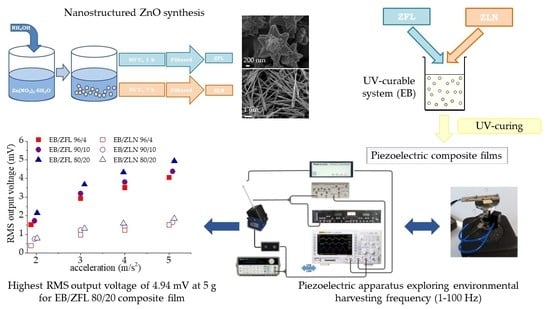Influence of Mechanical Properties on the Piezoelectric Response of UV-Cured Composite Films Containing Different ZnO Morphologies
Abstract
1. Introduction
2. Materials and Methods
2.1. Materials
2.1.1. Synthesis of ZnO Morphologies
2.1.2. Preparation of the Nanocomposite Films
2.2. Characterization Techniques
2.2.1. Fourier Transform Infrared (FTIR)-Attenuated Total Reflection (ATR) Spectroscopy
2.2.2. Scanning Electron Microscopy (SEM)
2.2.3. Wide-Angle X-ray Diffraction (WAXD)
2.2.4. Differential Scanning Calorimetry
2.2.5. Dynamic–Mechanical Analyses
2.2.6. Piezoelectric Measurement Setup
3. Results and Discussion
3.1. Morphological Analysis of ZnO Powders
3.2. WAXD Analysis of ZnO Nanostructures
3.3. Structural and Morphological Characterization of Composites
3.3.1. Assessment of the Completeness of the UV Curing Process with FTIR-ATR Spectroscopy
3.3.2. DSC Characterization of Composite Films
3.3.3. Morphological Analysis of EB-ZnO Surfaces
3.3.4. Structural Analysis of ZnO Composites
3.3.5. Dynamical–Mechanical Thermal Analyses of EB Composite Films
3.3.6. Piezoelectric Behavior at Low Frequencies (≤100 Hz)
4. Conclusions
Author Contributions
Funding
Institutional Review Board Statement
Data Availability Statement
Conflicts of Interest
References
- Maamer, B.; Boughamoura, A.; Fath El-Bab, A.M.R.; Francis, L.A.; Tounsi, F. A review on design improvements and techniques for mechanical energy harvesting using piezoelectric and electromagnetic schemes. Energy Convers. Manag. 2019, 199, 111973. [Google Scholar] [CrossRef]
- Bowen, C.R.; Kim, H.A.; Weaver, P.M.; Dunn, S. Piezoelectric and ferroelectric materials and structures for energy harvesting applications. Energy Environ. Sci. 2014, 7, 25–44. [Google Scholar] [CrossRef]
- Chang, C.; Tran, V.H.; Wang, J.; Fuh, Y.-K.; Lin, L. Direct-write piezoelectric polymeric nanogenerator with high energy conversion efficiency. Nano Lett. 2010, 10, 726–731. [Google Scholar] [CrossRef] [PubMed]
- Beeby, S.P.; Tudor, M.J.; White, N.M. Energy harvesting vibration sources for microsystems applications. Meas. Sci. Technol. 2006, 17, R175–R195. [Google Scholar] [CrossRef]
- Kim, H.S.; Kim, J.-H.; Kim, J. A review of piezoelectric energy harvesting based on vibration. Int. J. Precis. Eng. Manuf. 2011, 12, 1129–1141. [Google Scholar] [CrossRef]
- Dineva, P.; Gross, D.; Müller, R.; Rangelov, T. Piezoelectric Materials. In Dynamic Fracture of Piezoelectric Materials. Solid Mechanics and Its Applications; Springer: Cham, Switzerland, 2014; Volume 212. [Google Scholar]
- Steven, R.A.; Sodano, H.A. A review of power harvesting using piezoelectric materials. Smart Mater. Struct. 2007, 16, R1. [Google Scholar]
- Uchino, K. Advanced Piezoelectric Materials: Science and Technology; Woodhead Publishing: Cambridge, MA, USA, 2017. [Google Scholar]
- Sodano, H.A.; Inman, D.J.; Park, G. A Review of Power Harvesting from Vibration using Piezoelectric Materials. Shock. Vib. Dig. 2004, 36, 197–205. [Google Scholar] [CrossRef]
- Vijaya, M.S. Piezoelectric Materials and Devices: Applications in Engineering and Medical Sciences; CRC Press: Boca Raton, FL, USA, 2012. [Google Scholar]
- Panda, P.K.; Sahoo, B. PZT to Lead Free Piezo Ceramics: A Review. Ferroelectrics 2015, 474, 128–143. [Google Scholar] [CrossRef]
- Priya, S.; Song, H.-C.; Zhou, Y.; Varghese, R.; Chopra, A.; Kim, S.-G.; Kanno, I.; Wu, L.; Ha, D.S.; Ryu, J.; et al. A review on piezoelectric energy harvesting: Materials, methods, and circuits. Energy Harvest. Syst. 2019, 4, 3–39. [Google Scholar] [CrossRef]
- Nechibvute, A.; Chawanda, A.; Luhanga, P. Wireless sensor networks for scada and industrial control systems. Smart Mater. Res. 2013, 3, 853481. [Google Scholar]
- Wang, Z.L.; Zhu, G.; Yang, Y.; Wang, S.; Pan, C. Progress in nanogenerators for portable electronics. Mater. Today 2012, 15, 532–543. [Google Scholar] [CrossRef]
- Hiralal, P.; Unalan, H.; Amaratunga, G.A.J. Nanowires for energy generation. Nanotechnology 2012, 23, 194002. [Google Scholar] [CrossRef] [PubMed]
- Covaci, C.; Gontean, A. Piezoelectric Energy Harvesting Solutions: A Review. Sensors 2020, 20, 3512. [Google Scholar] [CrossRef] [PubMed]
- Soin, N.; Shah, T.H.; Anand, S.C.; Geng, J.; Pornwannachai, W.; Mandal, P.; Reid, D.; Sharma, S.; Hadimani, R.L.; Bayramol, D.V.; et al. Novel ‘‘3-D spacer’’ all fibre piezoelectric textiles for energy harvesting applications. Energy Environ. Sci. 2014, 7, 1670–1679. [Google Scholar] [CrossRef]
- Cha, S.N.; Kim, S.M.; Kim, H.; Ku, J.; Sohn, J.I.; Park, Y.J.; Song, B.G.; Jung, M.H.; Lee, E.K.; Choi, B.L.; et al. Porous PVDF as effective sonic wave driven nanogenerators. Nano Lett. 2011, 11, 5142–5147. [Google Scholar] [CrossRef] [PubMed]
- Signore, M.A.; De Pascali, C.; Duraccio, D.; Malucelli, G.; Fioravanti, A.; Melissano, E.; Martucci, M.C.; Masieri, M.; Siciliano, P.; Francioso, L. Synthesis and characterization of UV-curable nanocellulose/ZnO/AlN acrylic flexible films: Thermal, dynamic mechanical and piezoelectric response. J. Polym. Sci. 2021, 138, 49731. [Google Scholar] [CrossRef]
- Wang, Y.; Zhu, L.; Du, C. Progress in Piezoelectric Nanogenerators Based on PVDF Composite Films. Micromachines 2021, 12, 1278. [Google Scholar] [CrossRef]
- Choi, M.-Y.; Choi, D.; Jin, M.-J.; Kim, I.; Kim, S.-H.S.-W.; Choi, J.-Y.; Lee, S.Y.; Kim, J.M. Mechanically Powered Transparent Flexible Charge-Generating Nanodevices with Piezoelectric ZnO Nanorods. Adv. Mater. 2009, 21, 2185. [Google Scholar] [CrossRef]
- Ali, B.; Ashraf, M.W.; Tayyaba, S. Simulation, Fuzzy Analysis and Development of ZnO Nanostructure-based Piezoelectric MEMS Energy Harvester. Energies 2019, 12, 807. [Google Scholar] [CrossRef]
- Prashanthi, K.; Zhang, H.; Rao, V.R.; Thundat, T. Local piezoelectric response of ZnO nanoparticles embedded in a photosensitive polymer. Phys. Status Solidi RRL 2012, 6, 77–79. [Google Scholar] [CrossRef]
- Kandpal, M.; Sharan, C.; Poddar, P.; Prashanthi, K.; Apte, P.R.; Rao, V.R. Photopatternable nano-composite (SU-8/ZnO) thin films for piezoelectric applications. Appl. Phys. Lett. 2012, 101, 104102–104105. [Google Scholar] [CrossRef]
- Andrzejewska, E. Photopolymerization kinetics of multifunctional monomers. Prog. Polym. Sci. 2001, 26, 605–665. [Google Scholar] [CrossRef]
- Decker, C. Photoinitiated crosslinking polymerization. Prog. Polym. Sci. 1996, 21, 593–650. [Google Scholar] [CrossRef]
- Shukla, V.; Bajpai, M.; Singh, D.K.; Singh, M.; Shukla, R. Review of basic chemistry of UV-curing technology. Pigment. Resin Technol. 2004, 33, 272–279. [Google Scholar] [CrossRef]
- Malucelli, G.; Fioravanti, A.; Francioso, L.; De Pascali, C.; Signore, M.A.; Carotta, M.C.; Bonanno, A.; Duraccio, D. Preparation and characterization of UV-cured composite films containing ZnO nanostructures: Effect of filler geometric features on piezoelectric response. Prog. Org. Coat. 2017, 109, 45–54. [Google Scholar] [CrossRef]
- Rietveld, H.M. Line profiles of neutron powder-diffraction peaks for structure refinement. Acta Crystallogr. 1967, 22, 151–152. [Google Scholar] [CrossRef]
- Holzwart, U.; Gibson, N. The Scherrer equation versus the ‘Debye-Scherrer equation. Nat. Nanotechnol. 2011, 6, 534. [Google Scholar] [CrossRef] [PubMed]
- Jafarzadeh, S.; Johansson, M.; Sundell, P.E.; Claudino, M.; Pan, J.; Claesson, P.M. UV-curable acrylate-based nanocomposites: Effect of polyaniline additives on the curing performance. Polym. Adv. Technol. 2013, 24, 668–678. [Google Scholar] [CrossRef]
- Socrates, G. Infrared and Raman Characteristic Group Frequencies: Tables and Charts, 3rd ed.; Wiley: New York, NY, USA, 2004. [Google Scholar]
- Dorigato, A.; Pegoretti, A.; Dzenis, Y. Filler aggregation as a reinforcement mechanism in polymer nanocomposites. Mech. Mater. 2013, 61, 79–90. [Google Scholar] [CrossRef]
- Zabihia, O.; Mostafavi, S.M.; Ravari, F.; Khodabandeh, A.; Hooshafza, A.; Zare, K.; Shahizadeh, M. The effect of zinc oxide nanoparticles on thermo-physical properties of diglycidyl ether of bisphenol A/2,2′-diamino-1,1′-binaphthalene nanocomposites. Thermochim. Acta 2011, 521, 49–58. [Google Scholar] [CrossRef]
- Nielsen, L.E.; Landel, R.F. Mechanical Properties of Polymers and Composites; Marcel Dekker: New York, NY, USA, 1994. [Google Scholar]
- Jimenez, G.; Ogata, N.; Hawai, H.; Ogihara, T. Structure and thermal/mechanical properties of poly (ϵ-caprolactone)-clay blend. J. Appl. Polym. Sci. 1997, 64, 2211–2220. [Google Scholar] [CrossRef]
- Rahman, M.A.; Lee, B.-C.; Phan, D.-T.; Chung, G.-S. Fabrication and characterization of highly efficient flexible energy harvesters using PVDF–graphene nanocomposites. Smart Mater. Struct. 2013, 22, 085017. [Google Scholar] [CrossRef]
- Wang, X. Piezoelectric nanogenerators-harvesting ambient mechanical energy at the nanometer scale. Nano Energy 2012, 1, 13–24. [Google Scholar] [CrossRef]
- Slimani Tlemcani, T.; Justeau, C.; Nadaud, K.; Alquier, D.; Poulin-Vittrant, G. Fabrication of Piezoelectric ZnO Nanowires Energy Harvester on Flexible Substrate Coated with Various Seed Layer Structures. Nanomaterials 2021, 11, 1433. [Google Scholar] [CrossRef] [PubMed]
- Lee, M.; Bae, J.; Lee, J.; Lee, C.-S.; Hong, S.; Wang, Z.L. Self-powered environmental sensor system driven by nanogenerators. Energy Environ. Sci. 2011, 4, 3359–3363. [Google Scholar] [CrossRef]
- Zhang, G.; Zhao, P.; Zhang, X.; Han, K.; Zhao, T.; Zhang, Y.; Jeong, C.K.; Jiang, S.; Zhang, S.; Wang, Q. Flexible three-dimensional interconnected piezoelectric ceramic foam based composites for highly efficient concurrent mechanical and thermal energy harvesting. Energy Environ. Sci. 2018, 11, 2046–2056. [Google Scholar] [CrossRef]
- Fan, F.R.; Tang, W.; Wang, Z.L. Flexible Nanogenerators for Energy Harvesting and Self-Powered Electronics. Adv. Mater. 2016, 28, 4283–4305. [Google Scholar] [CrossRef]
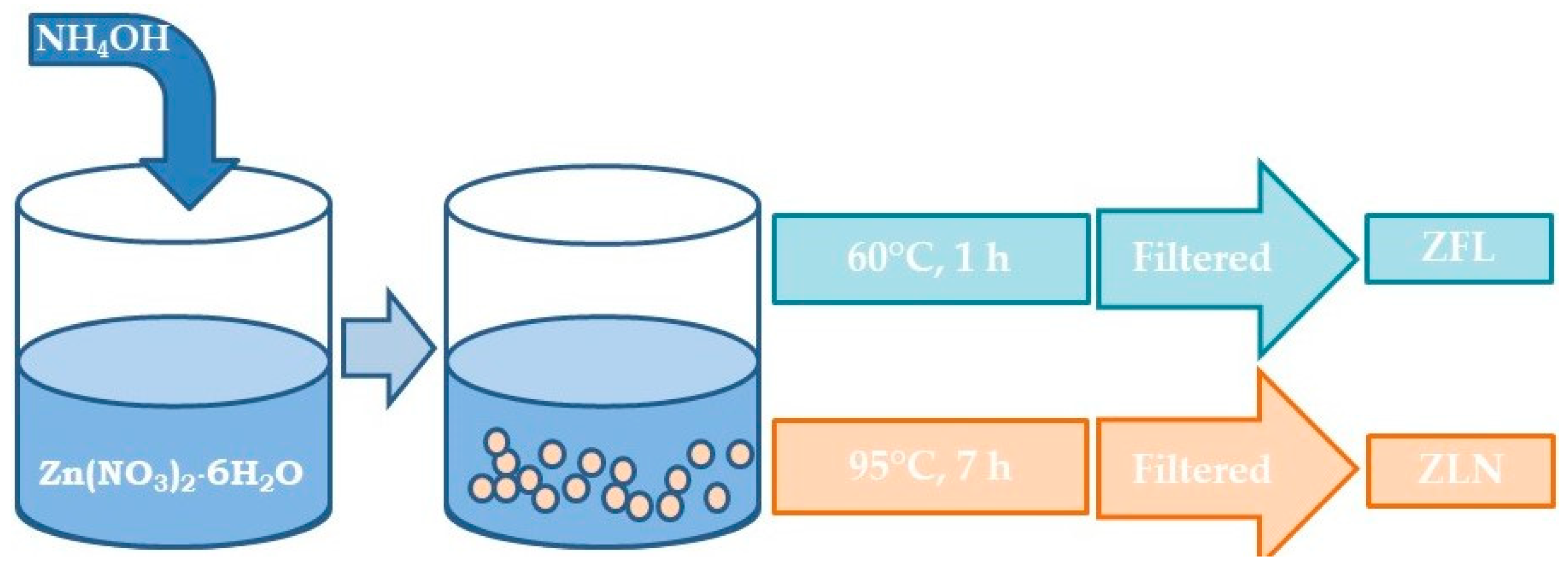

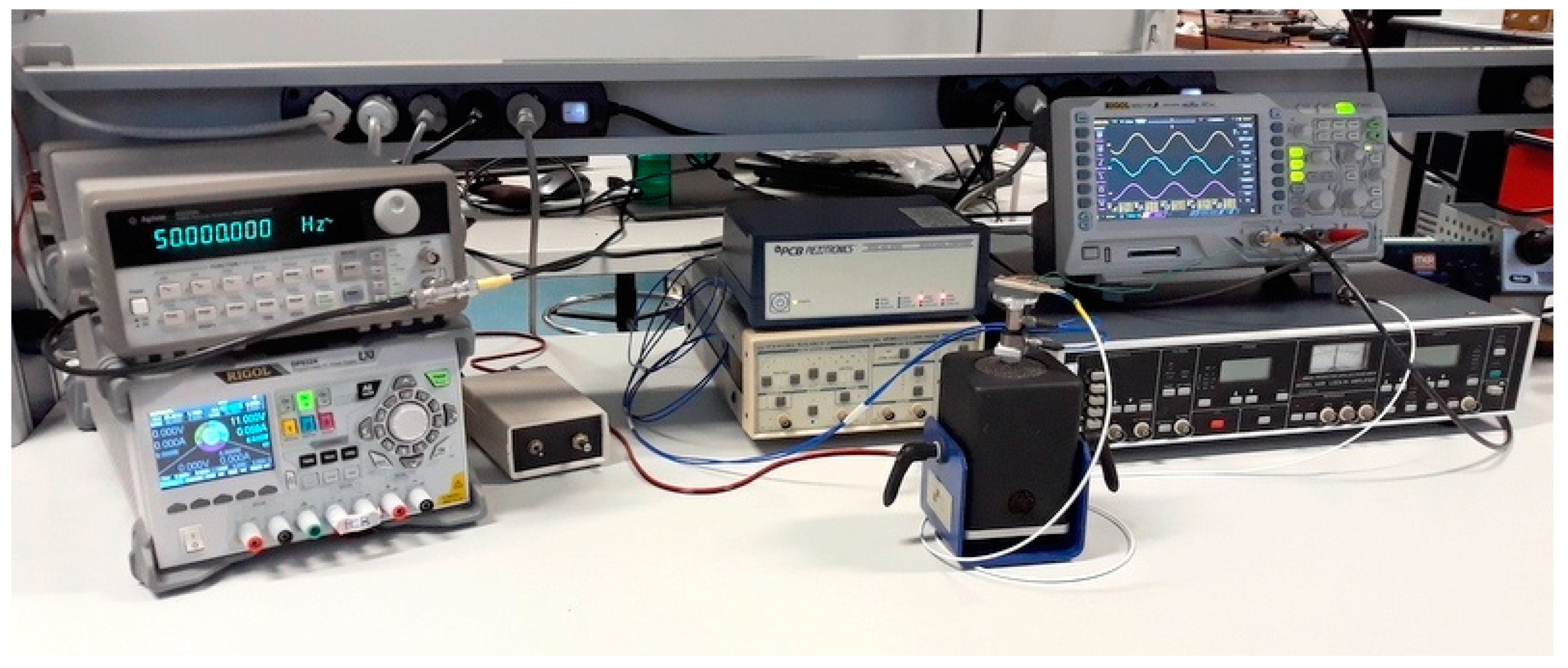
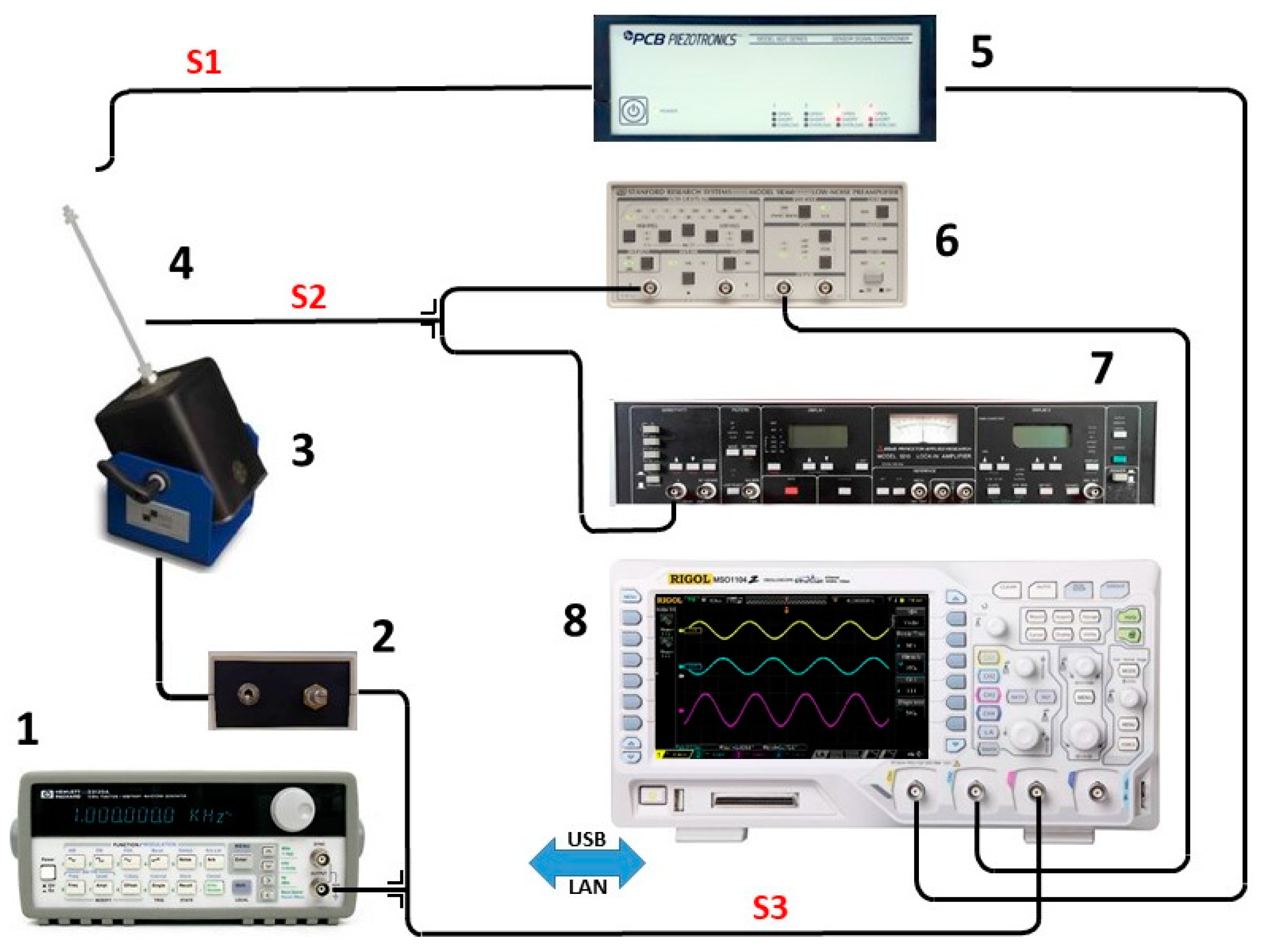
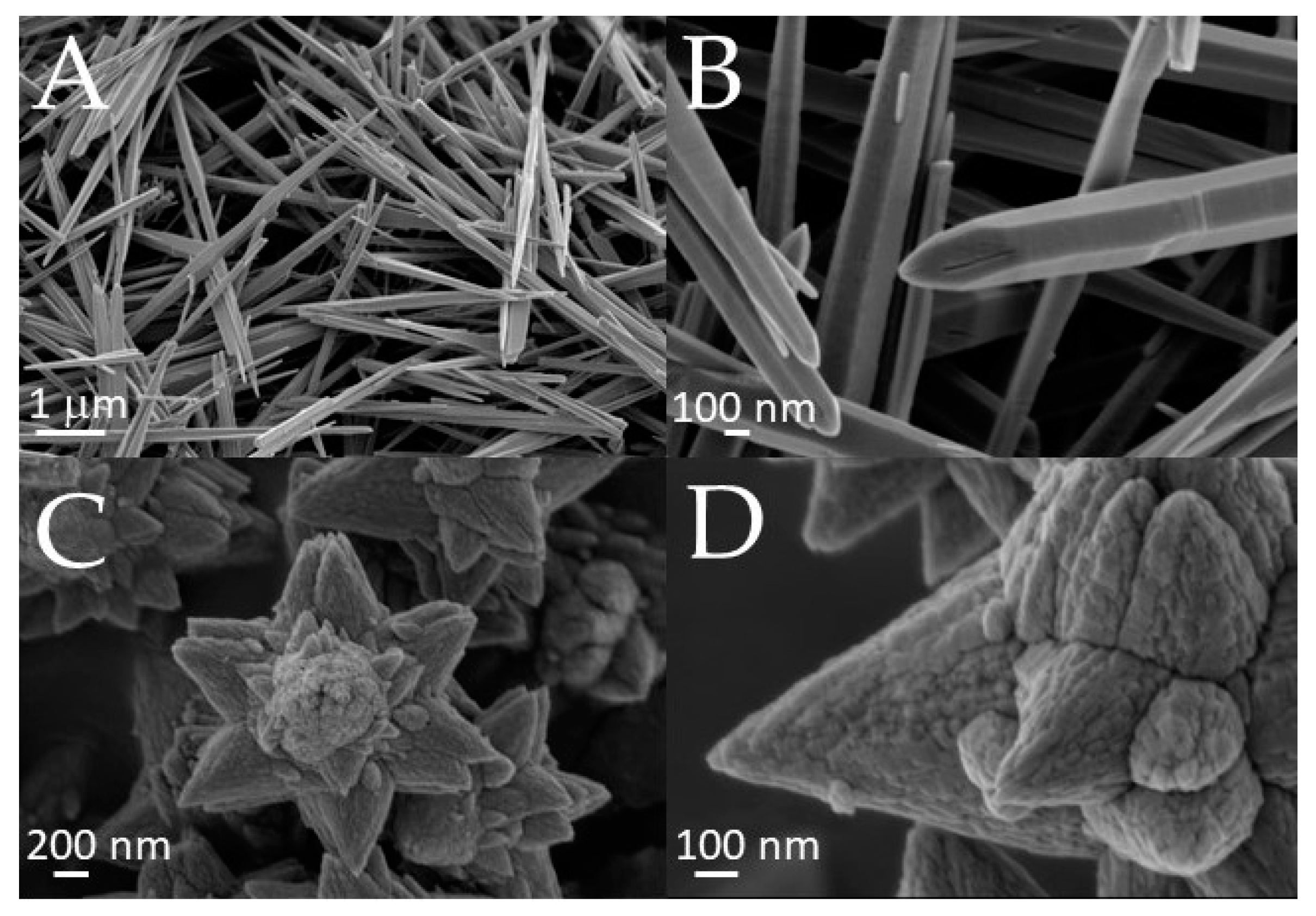
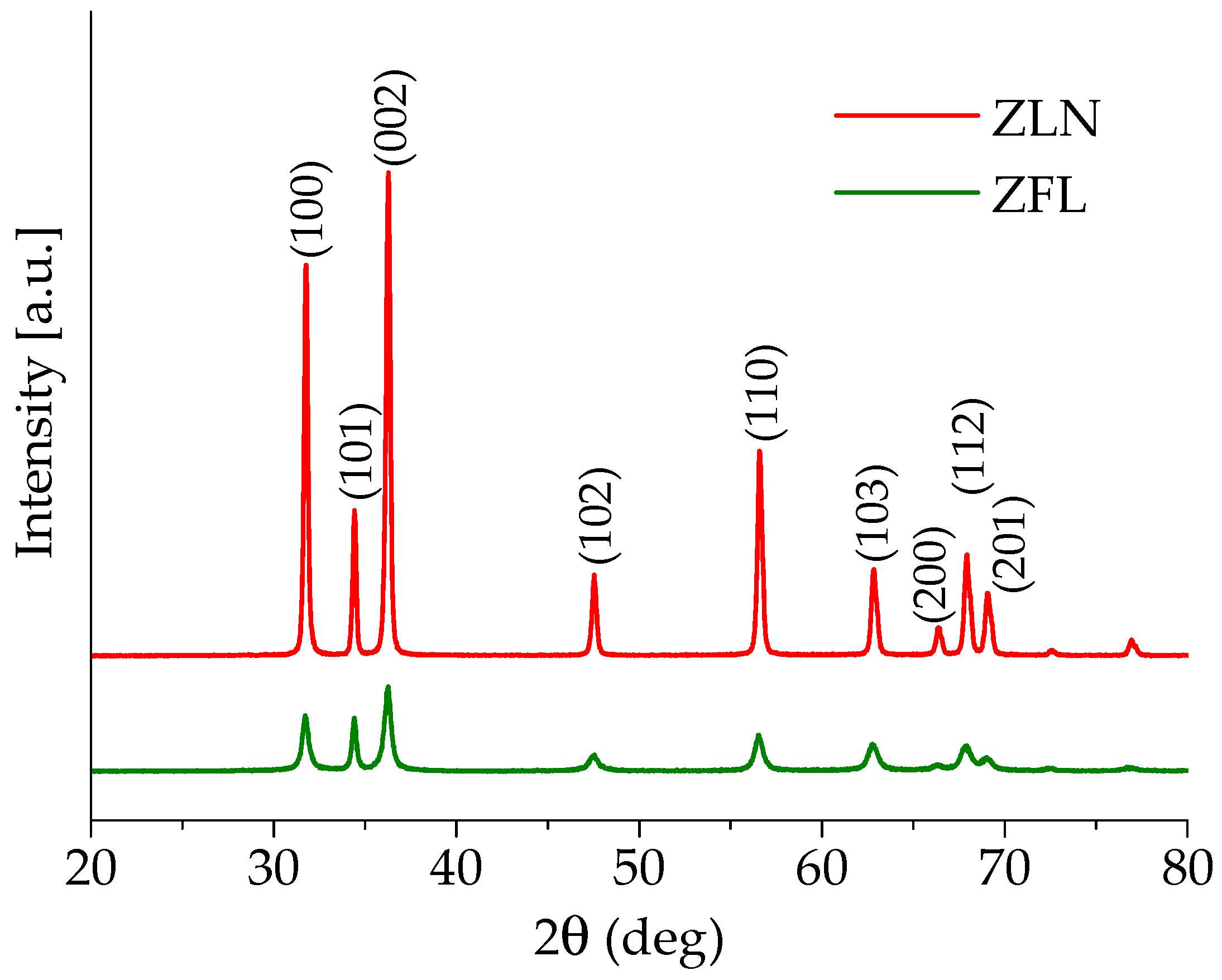


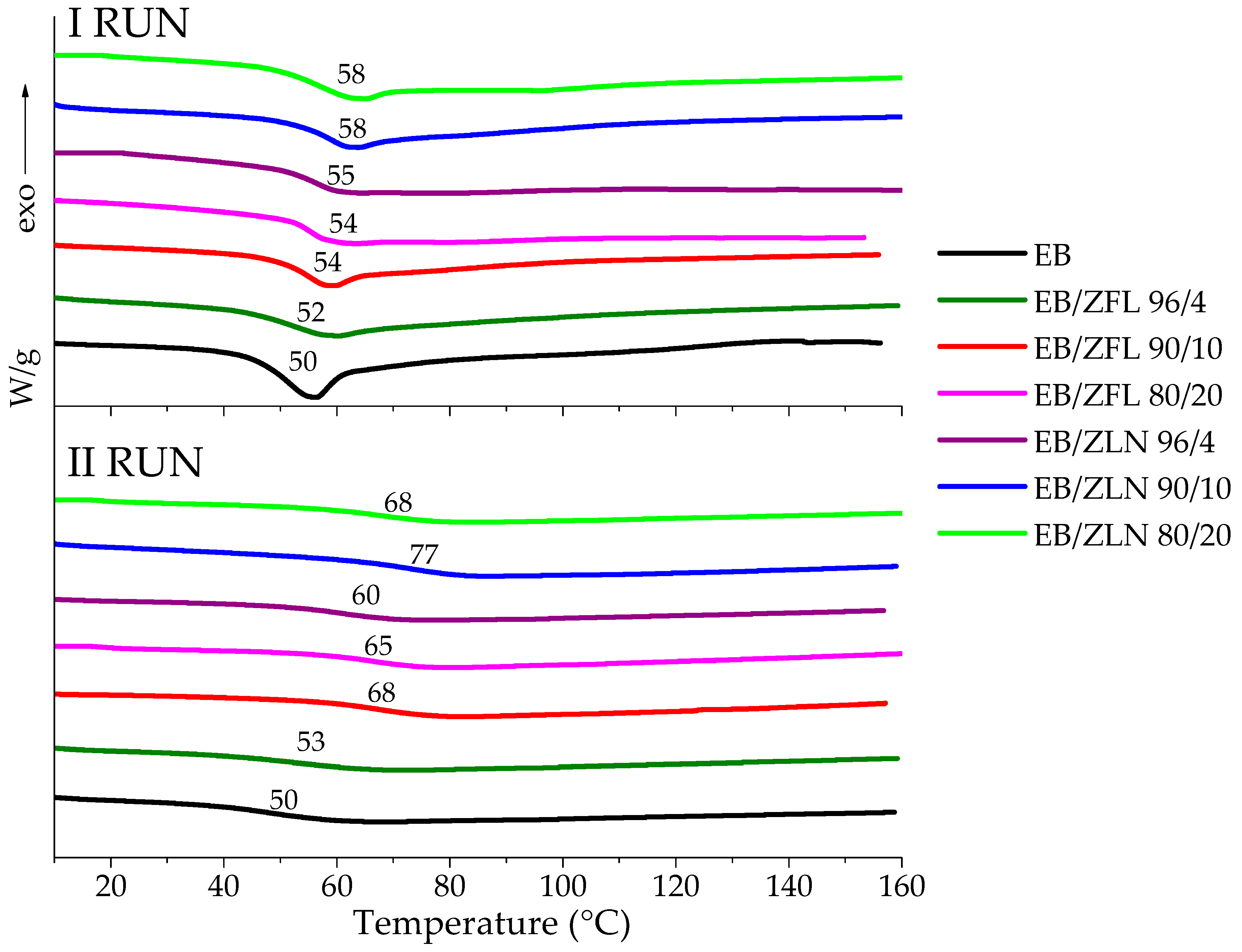
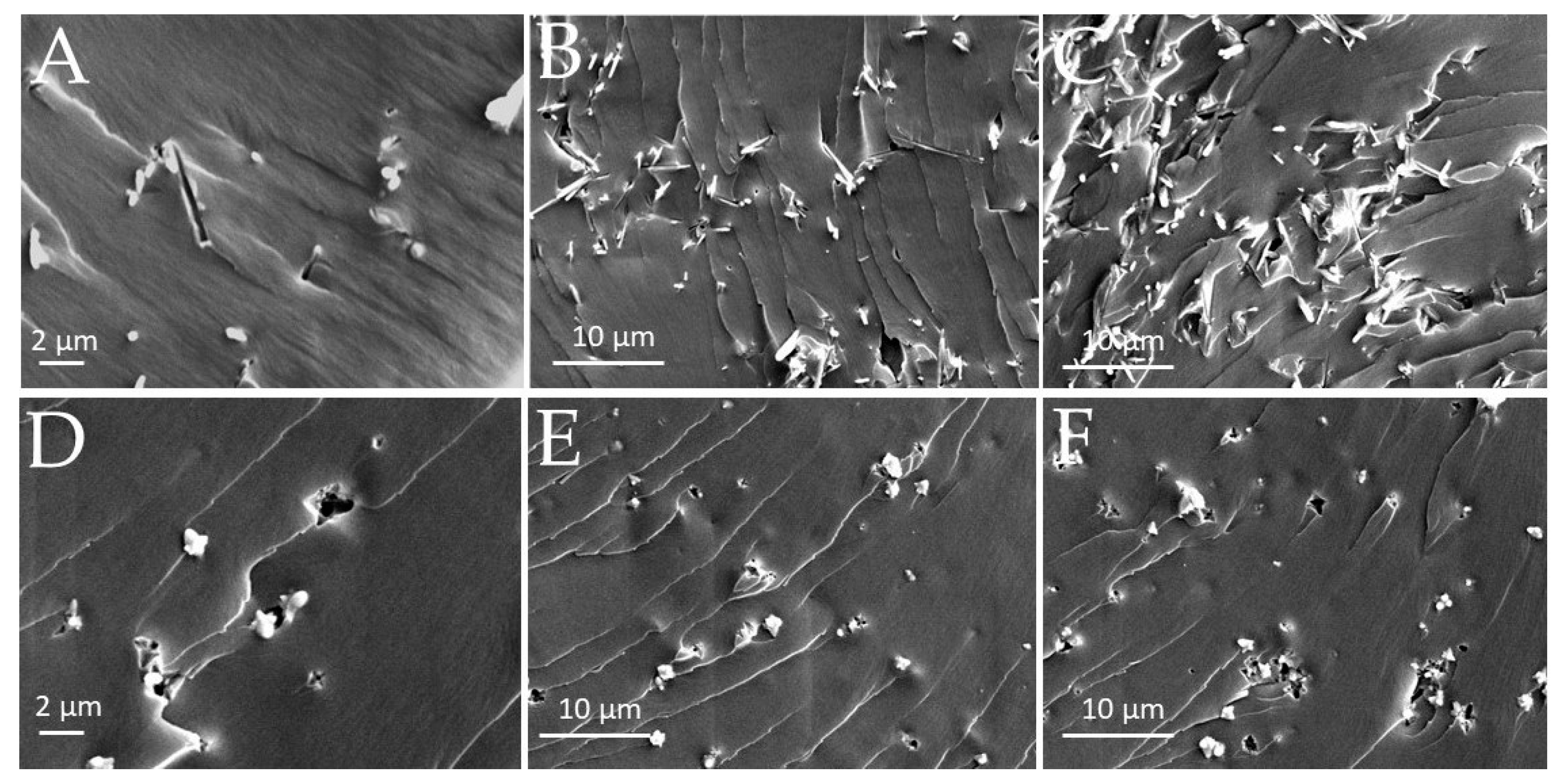


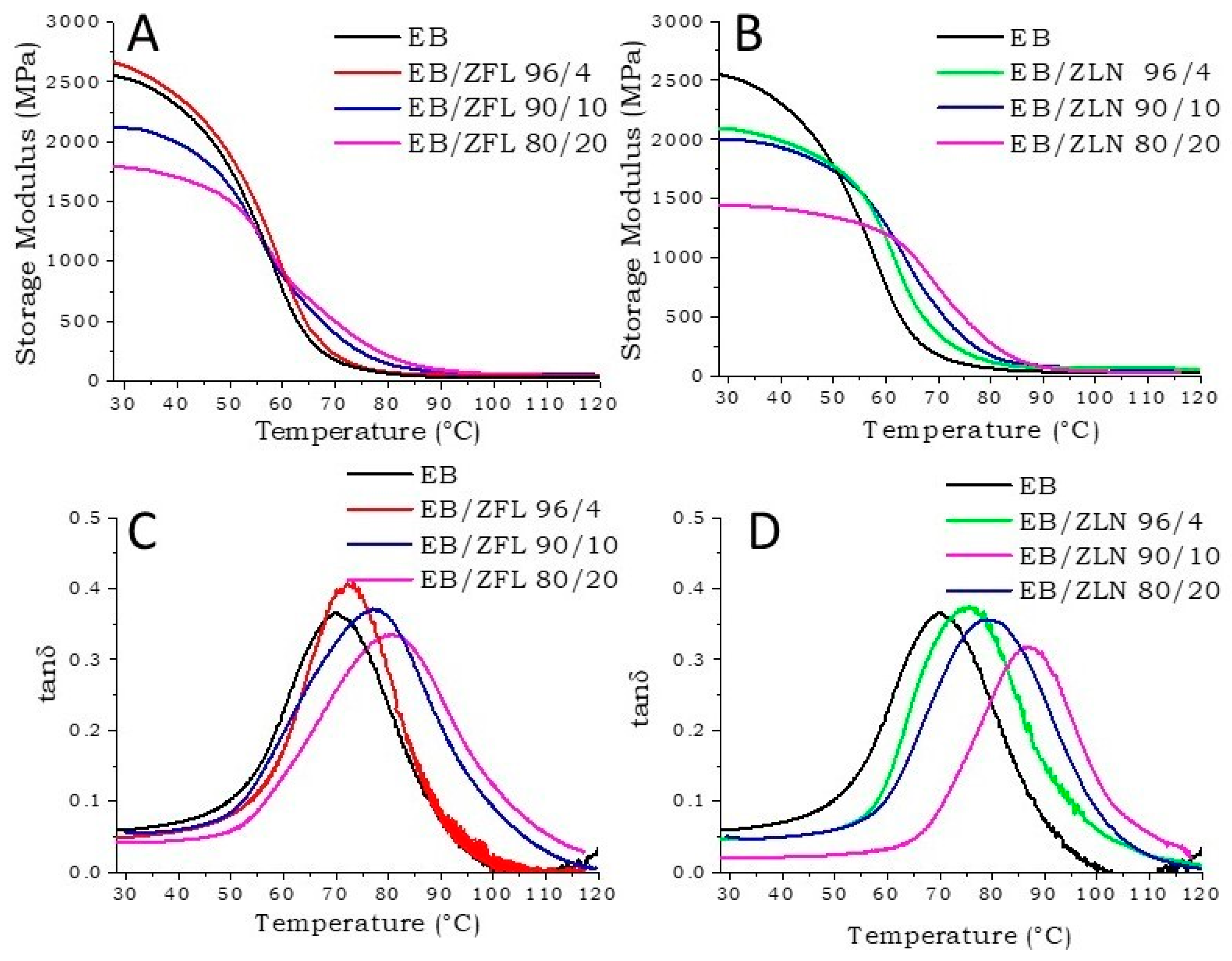
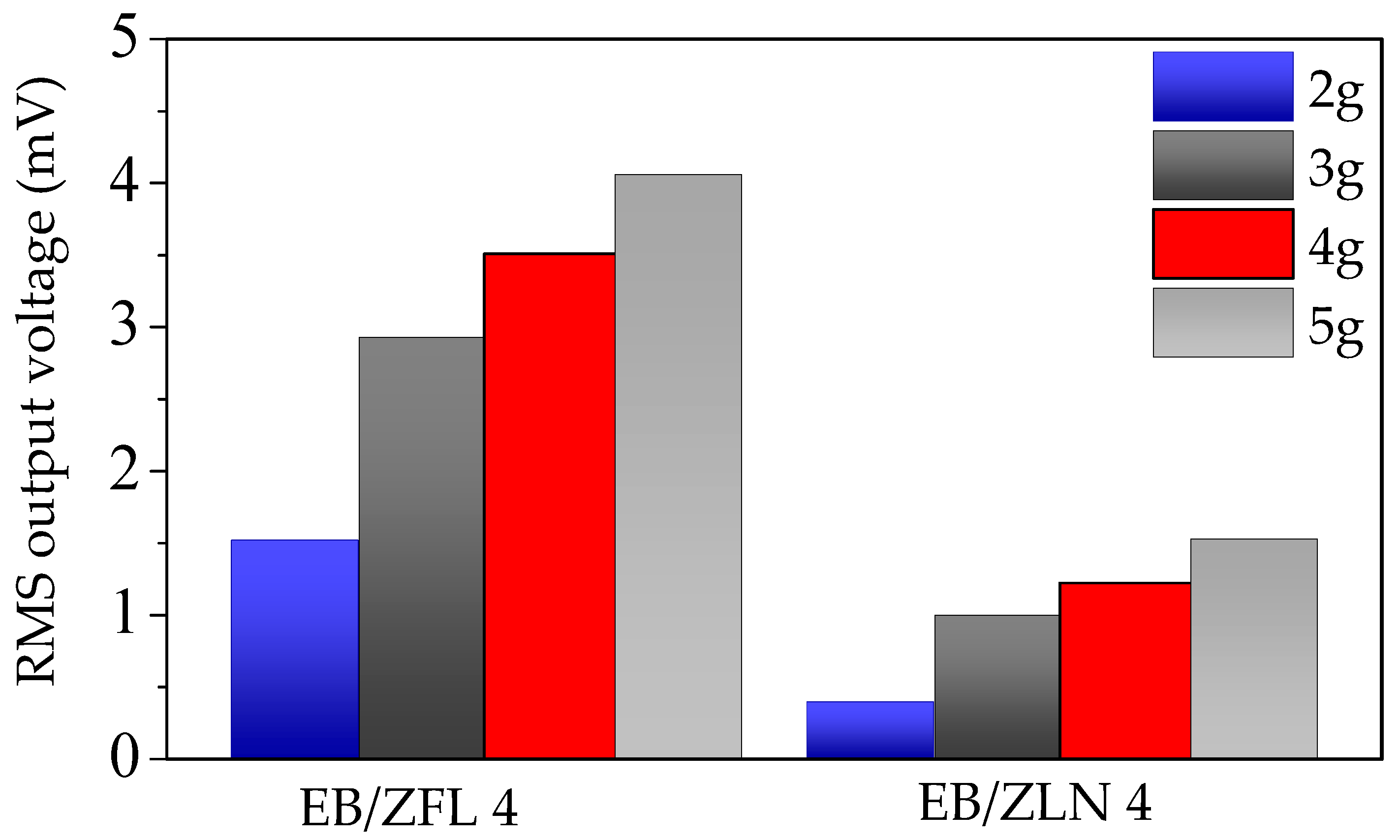

| Tg | E’ @ 30 °C | |
|---|---|---|
| EB | 70 ± 2 | 2537 ± 52 |
| EB/ZFL 96/4 | 73 ± 1 | 2637 ± 62 |
| EB/ZFL 90/10 | 78 ± 3 | 2111 ± 87 |
| EB/ZFL 80/20 | 81 ± 3 | 1791 ± 110 |
| EB/ZLN 96/4 | 75 ± 2 | 2089 ± 49 |
| EB/ZLN 90/10 | 80 ± 2 | 1984 ± 64 |
| EB/ZLN 80/20 | 86 ± 1 | 1439 ± 74 |
Disclaimer/Publisher’s Note: The statements, opinions and data contained in all publications are solely those of the individual author(s) and contributor(s) and not of MDPI and/or the editor(s). MDPI and/or the editor(s) disclaim responsibility for any injury to people or property resulting from any ideas, methods, instructions or products referred to in the content. |
© 2023 by the authors. Licensee MDPI, Basel, Switzerland. This article is an open access article distributed under the terms and conditions of the Creative Commons Attribution (CC BY) license (https://creativecommons.org/licenses/by/4.0/).
Share and Cite
Duraccio, D.; Capra, P.P.; Fioravanti, A.; Malucelli, G. Influence of Mechanical Properties on the Piezoelectric Response of UV-Cured Composite Films Containing Different ZnO Morphologies. Polymers 2023, 15, 1159. https://doi.org/10.3390/polym15051159
Duraccio D, Capra PP, Fioravanti A, Malucelli G. Influence of Mechanical Properties on the Piezoelectric Response of UV-Cured Composite Films Containing Different ZnO Morphologies. Polymers. 2023; 15(5):1159. https://doi.org/10.3390/polym15051159
Chicago/Turabian StyleDuraccio, Donatella, Pier Paolo Capra, Ambra Fioravanti, and Giulio Malucelli. 2023. "Influence of Mechanical Properties on the Piezoelectric Response of UV-Cured Composite Films Containing Different ZnO Morphologies" Polymers 15, no. 5: 1159. https://doi.org/10.3390/polym15051159
APA StyleDuraccio, D., Capra, P. P., Fioravanti, A., & Malucelli, G. (2023). Influence of Mechanical Properties on the Piezoelectric Response of UV-Cured Composite Films Containing Different ZnO Morphologies. Polymers, 15(5), 1159. https://doi.org/10.3390/polym15051159










